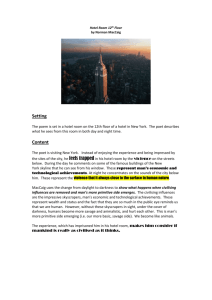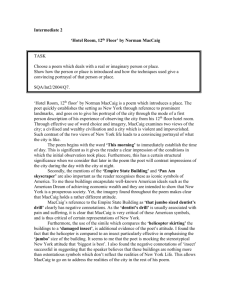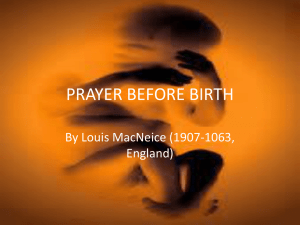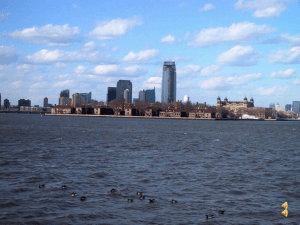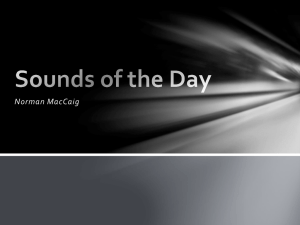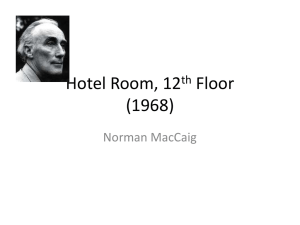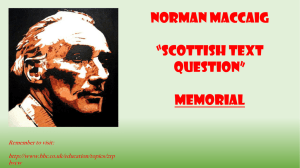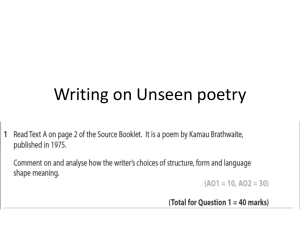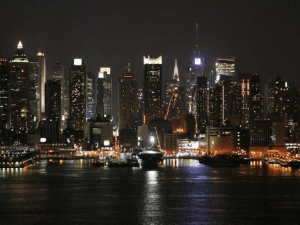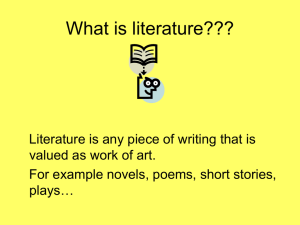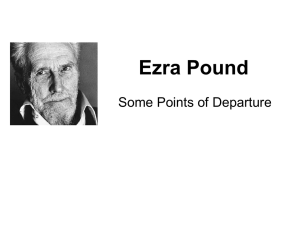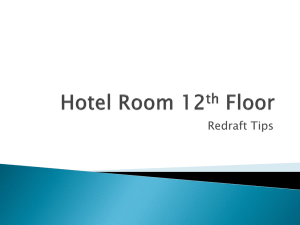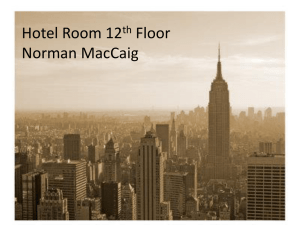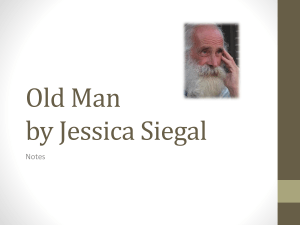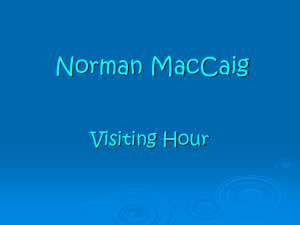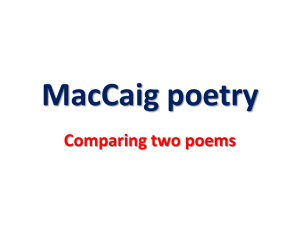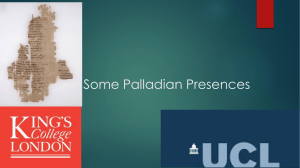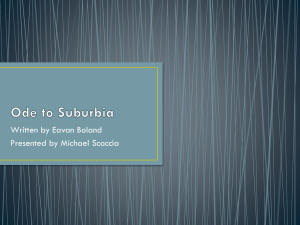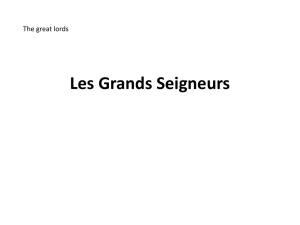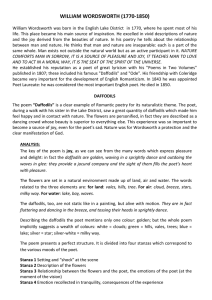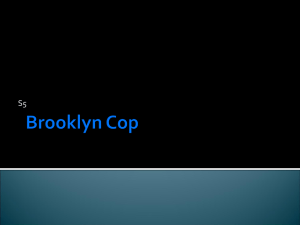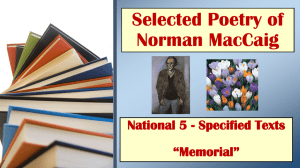Hotel Room, 12th Floor 2
advertisement
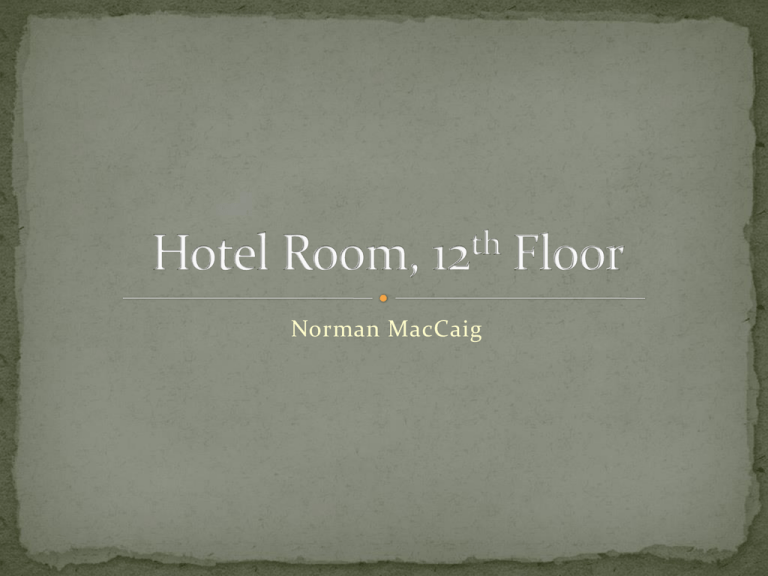
Norman MacCaig Make a note of any words you are unsure of. With your partner, discuss the poem and come up with 5 questions you are unsure of in your jotter. Watch the video of “Empire State of Mind” Using the whiteboards, note down at least 3 different ways that Jay Z is creating a certain impression of New York. How does Jay Z want to portray New York? The poem was written in 1968 It is set in a NYC that was characterised by its poverty and violence. New York writer Henry James described 1968 NYC as “ferocious and sinister” America was facing internal conflict over the Vietnam War, the civil-rights movement. NYC in 1969 faced racial tension, workers’ strikes and high unemployment. Write down at least one question for next lesson on the board. This morning I watched from here a helicopter skirting like a damaged insect the Empire State Building, that jumbo size dentist's drill, and landing on the roof of the Pan Am skyscraper. But now midnight has come in from foreign places. Its uncivilised darkness is shot at by a million lit windows, all ups and acrosses. But midnight is not so easily defeated. I lie in bed, between a radio and a television set, and hear the wildest of warwhoops continually ululating through the glittering canyons and gulches police cars and ambulances racing to the broken bones, the harsh screaming from coldwater flats, the blood glazed on sidewalks. The frontier is never somewhere else. And no stockades can keep the midnight out. Norman MacCaig Setting A hotel room on the 12th floor of a hotel in New York . The poet describes what he sees from this room in both day and night time. Content The poet is visiting New York . Instead of enjoying the experience and being impressed by the sites of the city, he feels trapped in his hotel room by the violence on the streets below. During the day he comments on some of the famous building of the New York skyline that he can see from his window. These represent man’s economic and technological achievements. At night he concentrates on the sounds of the city below him. These represent the violence that it always close to the surface in human nature. MacCaig uses the change from daylight to darkness to show what happens when civilising influences are removed and man’s more primitive side emerges. The experience, which has imprisoned him in his hotel room, makes him consider if mankind is really as civilised as it thinks. Stanza 1 The beginning of the poem creates a sense of immediacy in the poem: This morning I watched from here By stating the time at the beginning he suggests how deeply he was affected by his experience as he wants to write about it right away. This shows how important the themes and ideas of the poem were to him. This sense of immediacy is emphasised later in the stanza when he writes ‘But now Midnight has come in . . .’ He is writing the poem as he experiences the violence in the streets below. This conveys how powerful an impact his experience had on him. The opening also emphasises the poet’s isolation in the city he is visiting. He is an observer not a participant and we wonder why. Part of the answer is revealed when the poet describes what he sees from his window during the day. The imagery he uses is unexpected: I watched from here a helicopter skirting like a damaged insect the Empire State building, that jumbo-sized dentist drill, and landing on the roof of the PanAm skyscraper. Firstly he uses a simile comparing ‘a helicopter’ to ‘a damaged insect’. The comparison is effective as at a distance the size, sound and movement of the helicopter resemble an insect. However, his choice of the word ‘damaged’ suggests that he is not as impressed by this example of modern technology as we would expect. Insects also are often found around decaying remains so the image reminds us of death and dying. MacCaig seems to be suggesting that there is more this famous city than first meets the eye . In addition the metaphor he uses to describe the Empire State Building emphasises this idea. The shape of the building resembles ‘that jumbosized dentist drill’ because it narrows towards the top and has a long thin radio mast. The image of the drill suggests pain and suffering. Again MacCaig seems disturbed by what he sees. His tone is dismissive. He is unimpressed by these symbols of wealth and human achievement. For the poet these modern wonders are a veneer of civilisation over the true nature of the city. The next part of stanza one moves to night- time and the poet begins to develop an alternative view of the city: But now Midnight has come in from foreign places. Its uncivilised darkness is shot at by a million lit windows, all ups and acrosses. The poet personifies ‘Midnight’ by his use of the capital letter. Midnight is often associated with evil and the image suggests the evil side of human nature is now being displayed in the city. This idea is supported by his use of the expression ’uncivilised darkness’. He is referring to the dark side of human nature and the barbaric behaviour that results from it. MacCaig then extends this image of darkness by contrasting it with light. The ‘ups and acrosses’ remind us of the cross on which Christ died. As Christ is often described as ‘the light of the world’ the poet creates a contrast between good and evil. The image of the light shooting at the darkness suggests that good tries to overcome evil. It also creates a visual image of a crossword puzzle. However, in stanza two he goes on to suggest that this battle is not so easily won. Stanza 2 is set again in the poet’s hotel room at night. The night time setting, with its connotations of evil, is appropriate as he focuses on the violence and poverty of New York . This time it is not what he sees but what he hears he describes. The first thing that strikes us is how loud the streets below must be: I lie in bed, between a radio and a television set, These lines suggest the poet has both the radio and TV turned on to try to drown out the noise below. He goes on to show how unpleasant these noises are and what they represent about human behaviour. To do this, MacCaig begins an extended metaphor which not only cleverly describes the noise but creates a contrast between civilised and uncivilised society: the wildest of warwhoops continually ululating through the glittering canyons and gulches – The metaphor compares the sounds of the Native Americans of the old wild west to the ‘police cars and ambulances’ in the streets below. The ‘warwhoops’ are their cries as they go into battle. They remind us of the violence in the streets below that the ambulances and police cars are racing to. The ‘glittering canyons and gulches’ refer to the streets between the brightly lit modern skyscrapers and remind us of the landscape of the wild west where ambushes and violent battles took place. This similarity between America ’s past and present suggests that although mankind has advanced economically and technologically we are no more civilised than we were in our barbaric past. The poet next goes on to describe the results of the violence. The short list is an effective reminder of the pain and suffering hinted at in stanza one: . . . the broken bones, the harsh screaming from coldwater flats, the blood glazed on the sidewalks. The effective use of synecdoche depersonalises the suffering and so highlights that anyone can fall victim to violence. The sounds of pain are emphasised by the word ‘harsh’ but it is where the sounds come from that is important to the poet’s theme. It is not from the wealthy skyscrapers but from the run-down buildings without hot water where the poor live. They are the ones living in primitive conditions so it is hardly surprising that primitive behaviour is the result. His words emphasise the pain and suffering that poverty brings. The ‘blood glazed on the sidewalks’ suggests that violence and the pain and suffering it causes are always among us. Evil therefore is not just our violence but also the way society neglects the poor. He suggests in stanza 3 that we will pay for this neglect. In stanza 3 the poet sums up his thoughts but offers no solution to the problems of man’s violent nature. He continues the metaphor he began in stanza 2. The frontier is never somewhere else. The frontier in the wild west was the edge of civilisation. By saying it is ‘never somewhere else’ the poet is suggesting that evil or violence are always within us and we are no more civilised than our ancestors. MacCaig ends the poem with a pessimistic view of human nature: And no stockades can keep the midnight out. Stockades were high fences built to protect those who live inside them. What MacCaig is suggesting is that no matter how high we build our buildings, develop our technology or increase our prosperity, evil will always exist within us. His tone is despair at our inability to overcome our most basic instincts. He concludes by suggesting that evil will always overcome good. Choose a poem in which the poet creates a particular mood or atmosphere. Show how the poet creates this mood or atmosphere by his or her choice of subject matter and use of poetic techniques.
